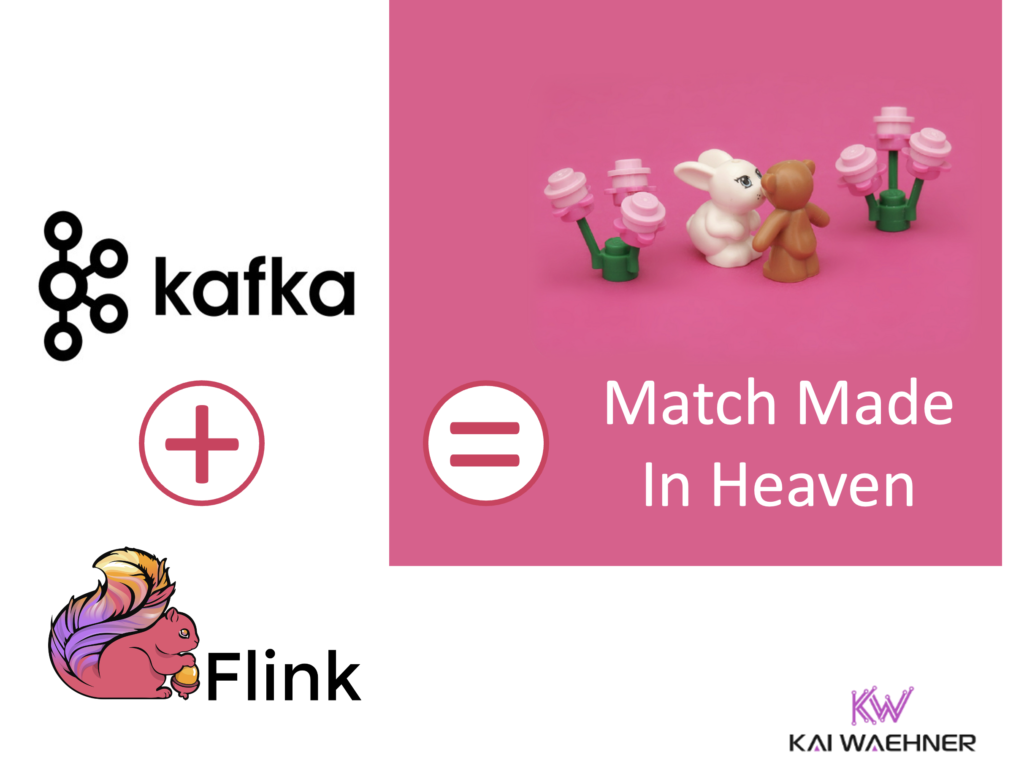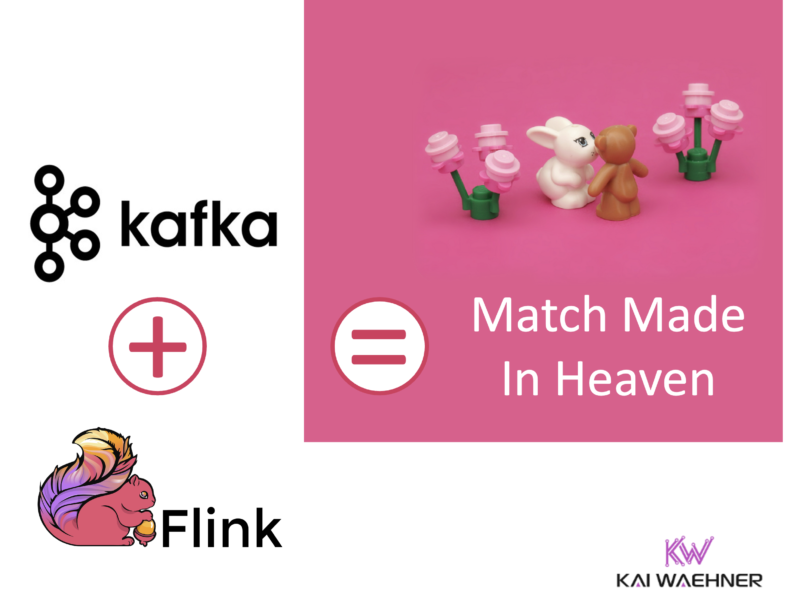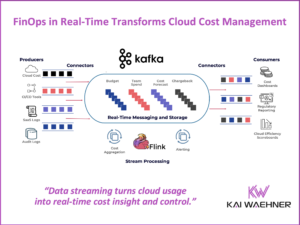Apache Kafka and Apache Flink are increasingly joining forces to build innovative real-time stream processing applications. This blog post explores the benefits of combining both open-source frameworks, shows unique differentiators of Flink versus Kafka, and discusses when to use a Kafka-native streaming engine like Kafka Streams instead of Flink.

The tremendous adoption of Apache Kafka and Apache Flink
Apache Kafka became the de facto standard for data streaming. The core of Kafka is messaging at any scale in combination with a distributed storage (= commit log) for reliable durability, decoupling of applications, and replayability of historical data.
Kafka also includes a stream processing engine with Kafka Streams. And KSQL is another successful Kafka-native streaming SQL engine built on top of Kafka Streams. Both are fantastic tools. In parallel, Apache Flink became a very successful stream processing engine.
The first prominent Kafka + Flink case study I remember is the fraud detection use case of ING Bank. The first publications came up in 2017, i.e., over five years ago: “StreamING Machine Learning Models: How ING Adds Fraud Detection Models at Runtime with Apache Kafka and Apache Flink“. This is just one of many Kafka fraud detection case studies.
One of the last case studies I blogged about goes in the same direction: “Why DoorDash migrated from Cloud-native Amazon SQS and Kinesis to Apache Kafka and Flink“.
The adoption of Kafka is already outstanding. And Flink gets into enterprises more and more, very often in combination with Kafka. This article is no introduction to Apache Kafka or Apache Flink. Instead, I explore why these two technologies are a perfect match for many use cases and when other Kafka-native tools are the appropriate choice instead of Flink.
Top reasons Apache Flink is a perfect complementary technology for Kafka
Stream processing is a paradigm that continuously correlates events of one or more data sources. Data is processed in motion, in contrast to traditional processing at rest with a database and request-response API (e.g., a web service or a SQL query). Stream processing is either stateless (e.g., filter or transform a single message) or stateful (e.g., an aggregation or sliding window). Especially state management is very challenging in a distributed stream processing application.
A vital advantage of the Apache Flink engine is its efficiency in stateful applications. Flink has expressive APIs, advanced operators, and low-level control. But Flink is also scalable in stateful applications, even for relatively complex streaming JOIN queries.
Flink’s scalable and flexible engine is fundamental to providing a tremendous stream processing framework for big data workloads. But there is more. The following aspects are my favorite features and design principles of Apache Flink:
- Unified streaming and batch APIs
- Connectivity to one or multiple Kafka clusters
- Transactions across Kafka and Flink
- Complex Event Processing
- Standard SQL support
- Machine Learning with Kafka, Flink, and Python
But keep in mind that every design approach has pros and cons. While there are a lot of advantages, sometimes it is also a drawback.
Unified streaming and batch APIs
Apache Flink’s DataStream API unifies batch and streaming APIs. It supports different runtime execution modes for stream processing and batch processing, from which you can choose the right one for your use case and the characteristics of your job. In the case of SQL/Table API, the switch happens automatically based on the characteristics of the sources: All bounded events go into batch execution mode; at least one unbounded event means STREAMING execution mode.
The unification of streaming and batch brings a lot of advantages:
- Reuse of logic/code for real-time and historical processing
- Consistent semantics across stream and batch processing
- A single system to operate
- Applications mixing historical and real-time data processing
This sounds similar to Apache Spark. But there is a significant difference: Contrary to Spark, the foundation of Flink is data streaming, not batch processing. Hence, streaming is the default execution runtime mode in Apache Flink.
Continuous stateless or stateful processing enables real-time streaming analytics using an unbounded stream of events. Batch execution is more efficient for bounded jobs (i.e., a bounded subset of a stream) for which you have a known fixed input and which do not run continuously. This executes jobs in a way that is more reminiscent of batch processing frameworks, such as MapReduce in the Hadoop and Spark ecosystems.
Apache Flink makes moving from a Lambda to Kappa enterprise architecture easier. The foundation of the architecture is real-time, with Kafka as its heart. But batch processing is still possible out-of-the-box with Kafka and Flink using consistent semantics. Though, this combination will likely not (try to) replace traditional ETL batch tools, e.g., for a one-time lift-and-shift migration of large workloads.
Connectivity to one or multiple Kafka clusters
Apache Flink is a separate infrastructure from the Kafka cluster. This has various pros and cons. First, I often emphasize the vast benefit of Kafka-native applications: you only need to operate, scale and support one infrastructure for end-to-end data processing. A second infrastructure adds additional complexity, cost, and risk. However, imagine a cloud vendor taking over that burden, so you consume the end-to-end pipeline as a single cloud service.
With that in mind, let’s look at a few benefits of separate clusters for the data hub (Kafka) and the stream processing engine (Flink):
- Focus on data processing in a separate infrastructure with dedicated APIs and features independent of the data streaming platform.
- More efficient streaming pipelines before hitting the Kafka Topics again; the data exchange happens directly between the Flink workers.
- Data processing across different Kafka topics of independent Kafka clusters of different business units. If it makes sense from a technical and organizational perspective, you can connect directly to non-Kafka sources and sinks. But be careful, this can quickly become an anti-pattern in the enterprise architecture and create complex and unmanageable “spaghetti integrations”.
- Implement new fail-over strategies for applications.
I emphasize Flink is usually NOT the recommended choice for implementing your aggregation, migration, or hybrid integration scenario. Multiple Kafka clusters for hybrid and global architectures are the norm, not an exception. Flink does not change these architectures.
Kafka-native replication tools like MirrorMaker 2 or Confluent Cluster Linking are still the right choice for disaster recovery. It is still easier to do such a scenario with just one technology. Tools like Cluster Linking solve challenges like offset management out-of-the-box.
Transactions across Kafka and Flink
Workloads for analytics and transactions have very unlike characteristics and requirements. The use cases differ significantly. SLAs are very different, too. Many people think that data streaming is not built for transactions and should only be used for big data analytics.
However, Apache Kafka and Apache Flink are deployed in many resilient, mission-critical architectures. The concept of exactly-once semantics (EOS) allows stream processing applications to process data through Kafka without loss or duplication. This ensures that computed results are always accurate.
Transactions are possible across Kafka and Flink. The feature is mature and battle-tested in production. Operating separate clusters is still challenging for transactional workloads. However, a cloud service can take over this risk and burden.
Many companies already use EOS in production with Kafka Streams. But EOS can even be used if you combine Kafka and Flink. That is a massive benefit if you choose Flink for transactional workloads. So, to be clear: EOS is not a differentiator in Flink (vs. Kafka Streams), but it is an excellent option to use EOS across Kafka and Flink, too.
Complex Event Processing with FlinkCEP
The goal of complex event processing (CEP) is to identify meaningful events in real-time situations and respond to them as quickly as possible. CEP does usually not send continuous events to other systems but detects when something significant occurs. A common use case for CEP is handling late-arriving events or the non-occurrence of events.
The big difference between CEP and event stream processing (ESP) is that CEP generates new events to trigger action based on situations it detects across multiple event streams with events of different types (situations that build up over time and space). ESP detects patterns over event streams with homogenous events (i.e. patterns over time). Pattern matching is a technique to implement either pattern but the features look different.
FlinkCEP is an add-on for Flink to do complex event processing. The powerful pattern API of FlinkCEP allows you to define complex pattern sequences you want to extract from your input stream. After specifying the pattern sequence, you apply them to the input stream to detect potential matches. This is also possible with SQL via the MATCH_RECOGNIZE clause.
Standard SQL support
Structured Query Language (SQL) is a domain-specific language used in programming and designed for managing data held in a relational database management system (RDBMS). However, it is so predominant that other technologies like non-relational databases (NoSQL) and streaming platforms adopt it, too.
SQL became a standard of the American National Standards Institute (ANSI) in 1986 and the International Organization for Standardization (ISO) in 1987. Hence, if a tool supports ANSI SQL, it ensures that any 3rd party tool can easily integrate using standard SQL queries (at least in theory).
Apache Flink supports ANSI SQL, including the Data Definition Language (DDL), Data Manipulation Language (DML), and Query Language. Flink’s SQL support is based on Apache Calcite, which implements the SQL standard. This is great because many personas, including developers, architects, and business analysts, already use SQL in their daily job.
The SQL integration is based on the so-called Flink SQL Gateway, which is part of the Flink framework allowing other applications to interact with a Flink cluster through a REST API easily. User applications (e.g., Java/Python/Shell program, Postman) can use the REST API to submit queries, cancel jobs, retrieve results, etc. This enables a possible integration of Flink SQL with traditional business intelligence tools like Tableau, Microsoft Power BI, or Qlik.
However, to be clear, ANSI SQL was not built for stream processing. Incorporating Streaming SQL functionality into the official SQL standard is still in the works. The Streaming SQL working group includes database vendors like Microsoft, Oracle, and IBM, cloud vendors like Google and Alibaba, and data streaming vendors like Confluent. More details: “The History and Future of SQL: Databases Meet Stream Processing“.
Having said this, Flink supports continuous sliding windows and various streaming joins via ANSI SQL. There are things that require additional non-standard SQL keywords but continuous sliding windows or streaming joins, in general, are possible.
Machine Learning with Kafka, Flink, and Python
In conjunction with data streaming, machine learning solves the impedance mismatch of reliably bringing analytic models into production for real-time scoring at any scale. I explored ML deployments within Kafka applications in various blog posts, e.g., embedded models in Kafka Streams applications or using a machine learning model server with streaming capabilities like Seldon.
PyFlink is a Python API for Apache Flink that allows you to build scalable batch and streaming workloads, such as real-time data processing pipelines, large-scale exploratory data analysis, Machine Learning (ML) pipelines, and ETL processes. If you’re already familiar with Python and libraries such as Pandas, then PyFlink makes it simpler to leverage the full capabilities of the Flink ecosystem.
PyFlink is the missing piece for an ML-powered data streaming infrastructure, as almost every data engineer uses Python. The combination of Tiered Storage in Kafka and Data Streaming with Flink in Python is excellent for model training without the need for a separate data lake.
When to use Kafka Streams instead of Apache Flink?
Don’t underestimate the power and use cases of Kafka-native stream processing with Kafka Streams. The adoption rate is massive, as Kafka Streams is easy to use. And it is part of Apache Kafka. To be clear: Kafka Streams is already included if you download Kafka from the Apache website.
Kafka Streams is a Library, Apache Flink is a cluster
The most significant difference between Kafka Streams and Apache Flink is that Kafka Streams is a Java library, while Flink is a separate cluster infrastructure. Developers can deploy the Flink infrastructure in session mode for bigger workloads (e.g., many small, homogenous workloads like SQL queries) or application mode for fewer bigger, heterogeneous data processing tasks (e.g., isolated applications running in a Kubernetes cluster).
No matter your deployment option, you still need to operate a complex cluster infrastructure for Flink (including separate metadata management on a ZooKeeper cluster or an etcd cluster in a Kubernetes environment).
TL;DR: Apache Flink is a fantastic stream processing framework and a top #5 Apache open-source project. But it is also complex to deploy and difficult to manage.
Benefits of using the lightweight library of Kafka Streams
Kafka Streams is a single Java library. This adds a few benefits:
- Kafka-native integration supports critical SLAs and low latency for end-to-end data pipelines and applications with a single cluster infrastructure instead of operating separate messaging and processing engines with Kafka and Flink. Kafka Streams apps still run in their VMs or Kubernetes containers, but high availability and persistence are guaranteed via Kafka Topics.
- Very lightweight with no other dependencies (Flink needs S3 or similar storage as the state backend)
- Easy integration into testing / CI / DevOps pipelines
- Embedded stream processing into any existing JVM application, like a lightweight Spring Boot app or a legacy monolith built with old Java EE technologies like EJB.
- Interactive Queries allow leveraging the state of your application from outside your application. The Kafka Streams API enables your applications to be queryable. Flink’s similar feature “queryable state” is approaching the end of its life due to a lack of maintainers.
Kafka Streams is well-known for building independent, decoupled, lightweight microservices. This differs from submitting a processing job into the Flink (or Spark) cluster; each data product team controls its destiny (e.g., don’t depend on the central Flink team for upgrades or get forced to upgrade). Flink’s application mode enables a similar deployment style for microservices. But:
Kafka Streams and Apache Flink live in different parts of a company
Today, Kafka Streams and Flink are usually used for different applications. While Flink provides an application mode to build microservices, most people use Kafka Streams for this today. Interactive queries are available in Kafka Streams and Flink, but it got deprecated in Flink as there is not much demand from the community. These are two examples that show that there is no clear winner. Sometimes Flink is the better choice, and sometimes Kafka Streams makes more sense.
“In summary, while there certainly is an overlap between the Streams API in Kafka and Flink, they live in different parts of a company, largely due to differences in their architecture and thus we see them as complementary systems.” That’s the quote of a “Kafka Streams vs. Flink comparison” article written in 2016 (!) by Stephan Ewen, former CTO of data Artisans, and Neha Narkhede, former CTO of Confluent. While some details changed over time, this old blog post is still pretty accurate today and a good read for a more technical audience.
The domain-specific language (DSL) of Kafka Streams differs from Flink but is also very similar. How are both characteristics possible? It depends on who you ask. This (legitimate) subject for debate often segregates Kafka Streams and Flink communities. Kafka Streams has Stream and Table APIs. Flink has DataStream, Table, and SQL API. I guess 95% of use cases can be built with both technologies. APIs, infrastructure, experience, history, and many other factors are relevant for choosing the proper stream processing framework.
Some architectural aspects are very different in Kafka Streams and Flink. These need to be understood and can be a pro or con for your use case. For instance, Flink’s checkpointing has the advantage of getting a consistent snapshot, but the disadvantage is that every local error always stops the whole job and everything has to be rolled back to the last checkpoint. Kafka Streams does not have this concept. Local errors can be recovered locally (move the corresponding tasks somewhere else; the task/threads without errors just continue normally). Another example is Kafka Streams’ hot standby for high availability versus Flink’s fault-tolerant checkpointing system.
Kafka + Flink = A powerful combination for stream processing
Apache Kafka is the de facto standard for data streaming. It includes Kafka Streams, a widely used Java library for stream processing. Apache Flink is an independent and successful open-source project offering a stream processing engine for real-time and batch workloads. The combination of Kafka (including Kafka Streams) and Flink is already widespread in enterprises across all industries.
Both Kafka Streams and Flink have benefits and tradeoffs for stream processing. The freedom of choice of these two leading open-source technologies and the tight integration of Kafka with Flink enables any kind of stream processing use case. This includes hybrid, global and multi-cloud deployments, mission-critical transactional workloads, and powerful analytics with embedded machine learning. As always, understand the different options and choose the right tool for your use case and requirements.
What is your favorite for streaming processing, Kafka Streams, Apache Flink, or another open-source or proprietary engine? In which use cases do you leverage stream processing? Let’s connect on LinkedIn and discuss it! Join the data streaming community and stay informed about new blog posts by subscribing to my newsletter.








